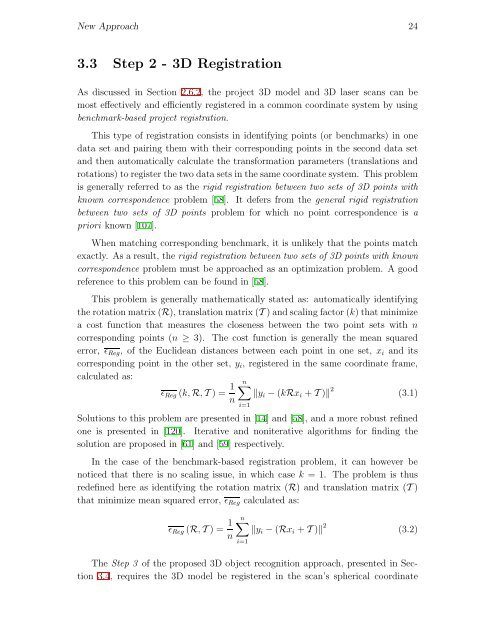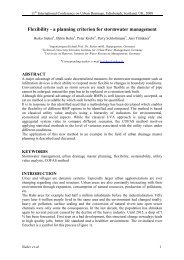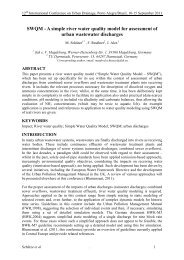PhD Thesis - Automated Recognition of 3D CAD Model Objects in ...
PhD Thesis - Automated Recognition of 3D CAD Model Objects in ...
PhD Thesis - Automated Recognition of 3D CAD Model Objects in ...
You also want an ePaper? Increase the reach of your titles
YUMPU automatically turns print PDFs into web optimized ePapers that Google loves.
New Approach 24<br />
3.3 Step 2 - <strong>3D</strong> Registration<br />
As discussed <strong>in</strong> Section 2.6.2, the project <strong>3D</strong> model and <strong>3D</strong> laser scans can be<br />
most effectively and efficiently registered <strong>in</strong> a common coord<strong>in</strong>ate system by us<strong>in</strong>g<br />
benchmark-based project registration.<br />
This type <strong>of</strong> registration consists <strong>in</strong> identify<strong>in</strong>g po<strong>in</strong>ts (or benchmarks) <strong>in</strong> one<br />
data set and pair<strong>in</strong>g them with their correspond<strong>in</strong>g po<strong>in</strong>ts <strong>in</strong> the second data set<br />
and then automatically calculate the transformation parameters (translations and<br />
rotations) to register the two data sets <strong>in</strong> the same coord<strong>in</strong>ate system. This problem<br />
is generally referred to as the rigid registration between two sets <strong>of</strong> <strong>3D</strong> po<strong>in</strong>ts with<br />
known correspondence problem [58]. It defers from the general rigid registration<br />
between two sets <strong>of</strong> <strong>3D</strong> po<strong>in</strong>ts problem for which no po<strong>in</strong>t correspondence is a<br />
priori known [107].<br />
When match<strong>in</strong>g correspond<strong>in</strong>g benchmark, it is unlikely that the po<strong>in</strong>ts match<br />
exactly. As a result, the rigid registration between two sets <strong>of</strong> <strong>3D</strong> po<strong>in</strong>ts with known<br />
correspondence problem must be approached as an optimization problem. A good<br />
reference to this problem can be found <strong>in</strong> [58].<br />
This problem is generally mathematically stated as: automatically identify<strong>in</strong>g<br />
the rotation matrix (R), translation matrix (T ) and scal<strong>in</strong>g factor (k) that m<strong>in</strong>imize<br />
a cost function that measures the closeness between the two po<strong>in</strong>t sets with n<br />
correspond<strong>in</strong>g po<strong>in</strong>ts (n ≥ 3). The cost function is generally the mean squared<br />
error, ɛReg, <strong>of</strong> the Euclidean distances between each po<strong>in</strong>t <strong>in</strong> one set, xi and its<br />
correspond<strong>in</strong>g po<strong>in</strong>t <strong>in</strong> the other set, yi, registered <strong>in</strong> the same coord<strong>in</strong>ate frame,<br />
calculated as:<br />
ɛReg (k, R, T )= 1<br />
n<br />
n�<br />
�yi − (kRxi + T )� 2<br />
i=1<br />
(3.1)<br />
Solutions to this problem are presented <strong>in</strong> [14] and [58], and a more robust ref<strong>in</strong>ed<br />
one is presented <strong>in</strong> [120]. Iterative and noniterative algorithms for f<strong>in</strong>d<strong>in</strong>g the<br />
solution are proposed <strong>in</strong> [61] and [59] respectively.<br />
In the case <strong>of</strong> the benchmark-based registration problem, it can however be<br />
noticed that there is no scal<strong>in</strong>g issue, <strong>in</strong> which case k = 1. The problem is thus<br />
redef<strong>in</strong>ed here as identify<strong>in</strong>g the rotation matrix (R) and translation matrix (T )<br />
that m<strong>in</strong>imize mean squared error, ɛReg calculated as:<br />
ɛReg (R, T )= 1<br />
n<br />
n�<br />
�yi − (Rxi + T )� 2<br />
i=1<br />
(3.2)<br />
The Step 3 <strong>of</strong> the proposed <strong>3D</strong> object recognition approach, presented <strong>in</strong> Section<br />
3.4, requires the <strong>3D</strong> model be registered <strong>in</strong> the scan’s spherical coord<strong>in</strong>ate













